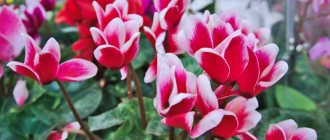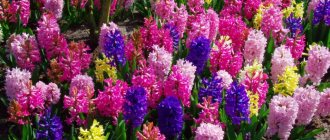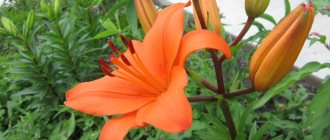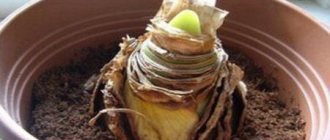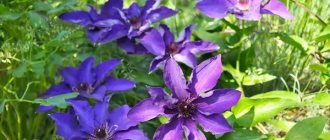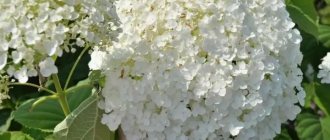Orchids are plants belonging to the Orchidaceae family, which accounts for 10% of all plants on Earth. This representative of the flora has about 35,000 species. Their name comes from the Greek word “orchis”, which means testicle. People have admired the beauty of the orchid for many centuries; in some countries it is even used as a national symbol. Representatives of this genus of flowers can be found on all continents of our planet; their main habitat is the tropics. The size of the plant can vary from 2 cm to 2 m . All orchids, according to their place of growth, are divided into epiphytic (growing on trees), letophytic (settle on rocks and stones) and terrestrial, and some species grow even underground.
Care after purchase
When the plant is just brought home, you need to send it to some kind of isolation for at least 2 weeks. Experienced flower growers recommend immediately replanting the flower in new soil to assess the condition of the roots and prevent diseases caused by possible incorrect care in the store.
After transplanting, the flower must be placed in a warm and bright place. The orchid should not be watered for at least four days after transplantation - if you cut the roots, the cuts may fester due to excess water.
So, two weeks passed, the flower took root well and showed no signs of disease. What kind of indoor care should I provide next? The orchid is a capricious flower native to the tropics. The whole essence of care comes down to organizing conditions that are similar in properties to the natural growing environment.
Brief information about the flower
There are about 35,000 species of orchids.
It is rare nowadays to meet a person who has never heard anything about orchids. Indoor plants differ significantly from their wild counterparts. Household orchids are presented in the form of flowerpots with thin stems, on the top of which are placed luxurious and outlandish flowers. Thanks to this, orchids have become incredibly popular among gardeners.
Also an important factor is their ease of care.
But caring for indoor orchids must meet the requirements, and it is also necessary to understand the conditions of their growth in natural conditions. Particular attention should be paid to selecting the appropriate substrate, container for planting, fertilizer, organizing proper watering, lighting, temperature and humidity. And also adhere to the recommended procedure for transplantation and reproduction. In the same way, you should not lose sight of what type of orchid you are going to grow, since each of them has its own characteristics.
Lighting
A wild orchid almost always receives diffused light. In this case, daylight hours last more than 12 hours. Therefore, it is worth choosing a place where there will be enough light, but at the same time not allowing direct sunlight to fall on the leaves.
It is worth taking care in advance to compensate for the insufficient duration of daylight hours: additional illumination with one 40 W light bulb is enough for the flower.
Where to place the plant in winter?
We must remember that orchids are not enthusiastic about any movement from room to room. Even painful. It’s better not to ask where to put the orchid in winter, but to immediately determine a permanent place for it.
Experienced flower growers are trying to determine a suitable location for them. So that the conditions are acceptable both in winter and summer. But not many people practice taking it out onto the balcony or into the garden for the summer.
But the defining ones are the types of orchids:
- Orchids in which the state of dormancy is not very pronounced . And caring for them is almost the same. It is necessary to highlight and maintain the temperature: Phalaenopsis;
- Paphiopedilum;
- Miltonia;
- Wanda.
- Dendrobium (some species);
- Tunia;
But for everyone:
- Be sure to maintain a good light regime - about 12 hours;
- And don't freeze it. The temperature should not fall below 14-16 degrees;
- But spraying must be stopped.
Be sure to add light to your orchids in winter.
Important! Consider the influence of heating systems and appliances. Humidification may be required. Be careful with ventilation. So as not to frostbite the Tropicans. The same window sills are quite suitable for wintering.
Temperature
In general, an orchid feels quite comfortable when indoors. The main thing is not to harm the flower with a random draft or air currents from the air conditioner: the orchid does not like cold air currents.
Cattleya
Orchids of this genus are among the most commonly found in culture and the most fascinating among many others. However, both beginners and experienced gardeners can complain about their pickiness and prolonged lack of flowering. When favorable conditions are created, the plant will delight its owner with excellent large flowers, which can be colored dark purple (almost black) or even snow-white. In addition, cattleyas are able to fill the entire surrounding space with a unique magical aroma, and the smell of some of them is reminiscent of lily of the valley or lily. In breeding, the flower formed the basis for a large number of hybrids, and today most countries have taken measures to protect this plant.
Air humidity
The tropical forest is incredibly humid: such conditions cannot be created in an apartment without the use of greenhouse structures. But there is no need for such excesses - it is enough to periodically spray the indoor plant with a spray bottle.
When spraying, you need to irrigate the entire plant, avoiding only the inflorescence. The water must be settled, always at room temperature. It is necessary to spray the orchid 3-4 times a week.
Feng Shui
What is Feng Shui? A well-known Taoist practice of symbolic exploration of space. Its proper organization. It allows you to take into account the favorable flows of Qi energy. For the benefit of humans.
Many scientists still consider this practice mystical and even pseudoscientific . In the East, Feng Shui is still respected.
Feng Shui is the science of organizing space.
What if we are not Chinese? Or not really:
- Someone smiles maliciously. Try to observe all this in practice;
- And someone follows them. Or pretends to comply.
But still. Why not use such centuries-old advice and conclusions. If they have a positive impact on your thoughts and actions. Even if you're not Chinese! After all, it is very difficult to judge how it really works:
- Successful, happy and prosperous people will definitely note that they honor Feng Shui;
- Losers who have numerous problems and unhappy people can also count Feng Shui as a reason.
So. Feng Shui. According to him, all fresh flowers were considered a source of positive emotions. According to Feng Shui, an orchid in an apartment is capable of many things:
- Helps develop willpower red and purple colors:
Extinguish and overcome laziness; - Set up to achieve your goals. Even follow a diet;
- Resolve pending matters. Quit smoking and exercise;
- Harmony in family relationships will be helped by placing them in the southwestern part of the apartment.
Red orchids help in developing willpower.
- There will be additional energy and productivity will increase;
- They have a beneficial effect on calming the nervous system and health. There will be no place for melancholy, apathy and depression. And inner harmony will appear;
Are we doing everything according to the laws and recommendations? Often the results are better. Contrary to recommendations. But as advised, it turned out far from the same. As expected. And they promised.
Orchids have been growing successfully in China for thousands of years. And they are deified. And they know how to handle and where to place an orchid according to Feng Shui.
Advice! Remember mutuality and symbiosis. Flowers feel care and attention. Some housewives like to talk with them. And they reciprocate. With its flowering and positive impact.
Regularity of watering
Orchid roots are extremely sensitive to both excess and lack of water. Understanding how to water a flower without harming it comes with time.
Most gardeners recommend watering orchids using the immersion method. The roots of the plant are extremely sensitive to humidity levels, and this method is the safest of all possible.
If signs of overwatering appear, then you need to carefully remove the orchid from the pot and remove the rotten parts of the roots. The soil should be replaced, because the old soil will remain excessively wet and the rotting process will start with renewed vigor. Naturally, after therapeutic manipulations, it will be necessary to review the frequency of watering.
If, on the contrary, the flower does not have enough moisture, it will let you know by thinning and yellowing of the leaves, followed by their falling off, starting from the lowest ones.
Energy of orchids
The usefulness and safety of a plant is not a simple question. It needs to be studied. So that you do not place an energy vampire in your home. Or a harmful plant.
This fully applies to orchids. And there are enough judgments and conclusions over their long history. There are many superstitions, secrets and riddles. And often contradictory:
- Since ancient times, it has been considered a symbol of love and tenderness . And the patroness of women. It only enhances and emphasizes femininity, charm and attractiveness. Healers made love potions from orchids;
- The orchid surprisingly unites two opposites. Masculinity and femininity. She embodies the strength and strength of family ties . They bring mutual understanding and respect to the home and family. Good care and a healthy plant are only beneficial for the whole family. And good mood;
- And it is also the protector of your home . They feel the presence of a person with bad intentions in the house. And they influence him in their own way. You may not feel it. But this will definitely affect the ill-wisher. And it will affect his well-being and mood;
- It is customary to give orchids to women . If a man has serious intentions. And pure thoughts.
Men and the orchid:
- The orchid seems to scare away men . By your presence in the house. Women suffering from loneliness are advised to know this;
- But they are not recommended to be placed in the bedrooms of boys and men.
Important! About safety for humans. There is an opinion that orchids are poisonous. It is wrong. But those suffering from allergies to pollen may have problems. But not from hybrids. The market offers them to us.
Soil selection
The right soil is half of successful care. When selecting soil, you need to know exactly the variety of your flower. If you are not sure about the type of plant you have, you can use a photo of the orchid to determine as accurately as possible whether it is a terrestrial or arboreal species.
If the orchid is a terrestrial variety, then additional nutritional supplements will need to be added to the standard orchid soil mixture.
Similar additives can be humus or a mixture of charcoal and peat. But varieties that naturally grow on trees do not need soil with additional nutrients, but they do need soil that will not interfere with the evaporation of excess moisture.
You need to mix into the base soil elements that loosen the soil and increase air circulation in it, for example expanded clay, oak or pine bark, moss or even the husks of ordinary seeds.
Orchids in the living room and hall
Exotic orchid - beautiful and delicate. It is a symbol of rebirth and family cohesion. The flower inspires creative individuals and enhances the desire to achieve goals. In a living room decorated in any oriental style, as well as Japanese or Chinese, an orchid will emphasize sophistication and sophistication, attention to detail and decorative elements. A plant placed on a coffee table in the middle of the room automatically becomes the center of the composition; it is impossible to take your eyes off it.
The space near orchids should not be crowded. All details fade into the background. Even white flowers will not get lost in the monochrome interior of the room if there are no other plants or decorations nearby.
In a large living room you can create a specific area with flowers. They can be different - high and low, bushy or solitary. It’s good if it is possible to use stands, racks, and select appropriate gratings for the vines. To them you can add a few more “modest”, inconspicuous plants that will fade into the background or serve as a background. You can see in the photo how to decorate a wall with orchids. Wallpaper, as a rule, should be pastel shades to further demonstrate the beauty of lilac, violet and lilac flowers framed by green leaves. A white flowerpot next to an inconspicuous wall lamp looks original.
Fertilizing
For successful development, the flower must receive soluble mineral fertilizers containing phosphorus, nitrogen and iron.
It is worth purchasing a complex balanced fertilizer and applying it according to the manufacturer’s instructions.
Pests
Spider mites are one of the most common pests that can destroy an orchid without proper action. The problem can be solved with a special product that can be purchased at any flower shop.
The next pest is mealybugs. They can be identified by a gray coating on the leaves. The first aid to combat them is to use a soap solution. Gently wipe the leaves, being careful not to get into the middle of the buds.
For plants with a greater degree of damage, use the drug Fitoverm. After dissolving it in water according to the instructions, spray it. Repeat after a couple of days to consolidate the effect.
Orchid pot: how to choose the optimal pot. Features of planting orchids with your own hands (145 photos and videos)- An orchid's roots dry out and rot - what to do and how to revive a drying flower. 125 photos and video instructions for restoring orchids
Orchid does not bloom at home: reasons, treatment methods and advice from gardeners on stimulating the plant (125 photos and videos)
If the spider mite and gray coating of the mealybug are not observed on other plants, then most likely you brought it from the store.
Reproduction
Orchids reproduce both by seeds and through the separation of shoots. Growing at home from seeds is a labor-intensive process, almost impossible for an inexperienced gardener.
The fact is that orchid seeds do not contain nutrients due to their structural features, and therefore they germinate successfully only on a sterile nutrient medium.
A much more common method is to grow “babies” - young plants formed either on a peduncle, on a stem, or at the root. When a shoot is formed, it is necessary to add an additional portion of nitrogen fertilizers for the comfortable development of both the baby and the mother plant.
It is necessary to move the baby into adulthood after the formation of 2-3 leaves and at least a pair of horses at least 5 cm long. You need to separate the shoot with a sharp knife, after which the cut needs to be treated with charcoal to prevent rotting.
The separated shoot is planted in a pot; at first, a fine substrate should be used as soil. Caring for a young orchid is generally similar to caring for an adult plant. Flowering should not be expected until the second year of life, depending on the variety.
Species features of indoor orchids
Orchid is a beautifully flowering ornamental plant that belongs to the orchid family. There are more than 25 thousand varieties and hybrids around the world. This is one of the most beautiful indoor plants, which is often given as a gift or used to make bouquets.
Plants are divided into two main groups
- Monopodial. They grow vertically in height and have one long stem. Several flower stalks emerge from shoots (pseudobulbs), which contain all the necessary nutrients and trace elements for healthy growth. Wide flat leaves have a rounded shape.
- Sympodial. They grow wide and look like vines with many shoots. They are united by a rhizome (rhizome), which serves as a stem. Pseudobulbs subsequently appear on it, from which new buds grow. Due to this, they visually look more bushy than monopodial ones, while the leaves of such specimens are narrow and oblong.
Each type has a different aroma with dominant notes of lemon, cinnamon and even coffee beans. Some have a barely perceptible sound, while others, on the contrary, scent the entire room.
On average, orchids bloom about 2-3 times a year, but there are varieties that, with proper care, delight with lush blooms all year round. Some varieties may have inconspicuous buds and inflorescences, but this is compensated by the beautiful and bizarre shape of the leaves. The shapes of inflorescences and color options depend on the variety. The peculiarity of the flower is symmetry. It consists of three sepals, two lateral petals and a central part - the lip. It can be painted in the color of the rest of the petals, stand out in a different tone or with bright splashes.
Not only leaves and stems take part in photosynthesis, but also the root system. Therefore, for most varieties, only transparent containers are suitable instead of ordinary pots. It is also better to leave some root branches above the ground.
- House plants
Garden at home: 9 best flowering indoor plants with names and photos
Transfer
The orchid needs to be replanted every 2 years. A complete change of soil and an increase in the volume of the pot are required.
Fresh soil is moistened in advance, the flower is transferred to a new pot, after which the plant must be left for three days in a place with a minimum of sunny color for comfortable adaptation. These three days the plant does not need to be watered.
Lelia
Graceful lelia is rightfully considered one of the most attractive representatives of orchids. This sophisticated and graceful beauty, rich in lilac-pink shades, stands out against the background of other more common species. This genus contains both large and miniature plants, which will allow even the most demanding gardener to find a suitable variety. When choosing a lelia, you must remember that it needs high-quality care and prefers coolness and fresh air.
Yellowing leaves
The gradual death of the lower leaf is considered natural. If several leaves of a plant begin to turn yellow at the same time, this should be taken as an alarming signal.
First of all, inspect the plant for the presence of pests, and if none are found, then consider watering and feeding the orchid: most likely, it does not have enough nutrition.
Wanda
This variety is distinguished by its height, which can reach one meter, and fairly large flowers, of which up to 15 can form on one shoot. Their color in the first days of flowering has pale shades, and after a few days it acquires rich tones.
By the way, the palette of vanda petals is incredibly wide: they can be snow-white, pale blue, purple, yellow, orange or red. Species of this orchid can be quite easily crossed, both within their own genus and with their other relatives. Therefore, in nature there is a wide variety of interspecific and intergeneric hybrids.
The plant has powerful roots covered with a layer of porous dead cells, which allows it to receive moisture even from the atmosphere and protect itself from water deficiency and burns.
Lack of flowers
It is worth understanding that a completely healthy plant will definitely bloom. Most often, adding abundant fertilizing during the growing season and changing lighting conditions helps.
First of all, try to increase the length of daylight hours - orchid flowers are even worth the additional costs of creating artificial lighting.
Orchids in the nursery on the window
Placing fresh flowers in a child's room is not always justified, since in this case special attention will have to be paid to safety precautions and compliance with a number of sanitary and hygienic standards. Let them first learn to care for the flowers growing in the living room or kitchen, under strict parental supervision. But younger schoolchildren are already quite capable of watering and monitoring the condition of plants on their own. You can put a pot with a plant on the window in their room. However, you need to take into account that the strong smell of an orchid can cause an allergic reaction in a child, so it is better to decorate the window sill in a child’s room with artificial analogues or other, less “fragrant” flowers. Orchids in the kitchen in a basket
Plants are very appropriate in the design of a modern kitchen. They will be an important detail at a romantic dinner. Their delicate scent will complement the aroma of tea or wine. Orchids look great in a low, stable basket placed on a windowsill or kitchen cabinet top. When decorating a festive table, we must also not forget about these plants, whose exquisite beauty will decorate any feast with the most expensive menu. Even in a Provence-style kitchen, orchids will not be out of place. The abundance of light and air, characteristic of French country, will organically merge with delicate pink or purple flowers.
The simple and strict lines of modernism and minimalism also do not interfere with the placement of orchids in the kitchen. On the contrary, thanks to the limited number of details and decorative elements, flowers acquire even greater significance and value for decoration.
In the bathroom, if there are windows and enough light, you can also place orchids. But if they cannot create comfortable conditions, you will have to limit yourself to images of these tropical beauties on ceramic tiles or mosaic panels.
Orchids in the interior of an apartment are a phenomenon that still remains extraordinary. Do you want to surprise guests or relatives? Invite them as the plants begin to bloom. It is unlikely that you will be able to see and experience so many positive emotions and admiration at any other time.
Fungi and rot
Due to excessive watering, rot or fungi sometimes appear. To get rid of them, it is necessary to cut off all affected areas as quickly as possible and treat the sections with a fungicide.
With the correct selection of growing conditions, all regular care will consist of timely watering. Understanding the right moment for watering comes with experience, and following other simple rules of care at home allows you to admire abundant flowering.
Orchids in the interior of the apartment
This amazingly beautiful flower is surrounded by a whole veil of superstitions. It is believed that the orchid is a vampire plant; it is not recommended to keep it in the bedroom, as it draws life energy from other plants and humans. However, this is due to the fact that its pollen sometimes causes drowsiness and lethargy in humans, and the strong smell characteristic of some species can cause headaches.
Many people believe that this plant repels men, while at the same time they claim that it increases female attractiveness, energy and charm. According to Feng Shui, orchids attract good things into the home, help get rid of negativity and cope with problems.
Most often, plants are placed on the windowsill. However, the culture is very plastic, flowers can adapt to the characteristics of the environment, so the choice of possible location is unlimited. It is only important that the degree of illumination is acceptable for the flower, and strict adherence to temperature and humidity is also necessary. These plants look quite natural in an elegant setting, although they perfectly complement and decorate any interior (with the exception of rustic, rustic, Romanesque, ethno, punk).
Photo of home orchid
What an orchid flower looks like - general description
There are more than 30,000 species and varieties of orchids in nature. Therefore, it is difficult to give an unambiguous description. Among the wide variety there are varieties with long and short stems, straight and creeping.
The arrangement of the leaves is regular. The flowers are painted in all the colors of the rainbow. Orchid inflorescences come in the form of a brush or spike. At the top of the flower there are 3 sepals, often fused together, at the bottom there are 3 petals.
In the middle there is a petal that looks like a shoe. This is a lip; it contains a nectary. Flowers are pollinated by insects. Ripe seeds are carried by the wind. Those of them that fall on the mycelium will be able to germinate.
DIY orchid pot
You can also make a pot for growing orchids yourself. To do this, you need to prepare a plastic base, for example, a food container. Choose the shape yourself, and the volume of the structure should correspond to the size of the flower . You need to make a large number of through holes in the bottom of the container with a knife, screwdriver or drill; it is advisable to also make them in the side walls of the homemade pot. Place a shampoo stopper inside the middle of the container so that the flower cannot fit tightly to the bottom of the container and breathes better.
Choosing orchids when purchasing
The importance of studying a variety before purchasing and growing orchids yourself has already been said. Now you need to look at the question of how to choose an orchid when buying , what you should pay attention to.
So, when choosing orchids you should pay attention to four important factors:
- Root system - choose only those specimens that are planted in transparent pots, this will make it easier to determine the condition of the flower. Pay attention to the color of the roots - they should be green or grayish. During the active growth stage, the ends of the roots are always green. This same aspect guarantees the health of the plant. Do a little test - shake the pot in your hands. The plant should not “dangle” in the soil.
- Leaves - should be elastic and dense, green or close to a grassy shade. Some varieties should have a red edge. The surface of the leaves should be smooth. An “accordion” leaf indicates a lack of moisture, and a too dark shade indicates growth in the shadow zone and a lack of sunny color.
- Peduncle - blooming flowers should be even and elastic. It is better to purchase those specimens where, along with the opened flowers, there are also newly developed buds. Otherwise, after purchasing you risk finding yourself without a beautiful inflorescence. When changing its location, the orchid may shed its existing flowers.
- Age – Orchids can be divided into mature specimens and seedlings. The seedling is still at the stage of leaf formation; the absence of a peduncle is noted. It may take several more years before you can enjoy the beauty of flowers. It is better to choose mature individuals, since they can please you with flowers in the near future.
If you do not have certain experience and knowledge about growing orchids from the moment of planting the seedling, it is better to choose already mature specimens in order to carry out all the steps of growing the flower and enjoy its beauty.
How to care for orchids.wmv
Artificial or live
Of course, nothing better than living plants has yet been invented. However, not everyone has the opportunity to keep real orchids at home, since these are quite delicate tropical flowers, and their cultivation requires special conditions.
Artificial orchid on the window
But nothing prevents you from using images of orchids and their artificial analogues. In addition, a high-quality artificial variation sometimes looks no different from a real one. And in terms of texture, they have now almost “caught up” with their living counterparts. And you don’t need to care for artificial flowers; you don’t need to create any special maintenance conditions either. Total benefit. And they decorate the interior just like living ones. Therefore, there is nothing wrong with using artificial orchids. In addition, they can be selected individually to suit your design, taking into account its colors and overall style. Tiles and wallpaper with a picture of a flower are also a worthy option for decorating an apartment with little blood.
Refrigerator with an image of an orchid Modular painting in the living room with an image of an orchid
Modern botanical classification
According to the growing environment and the method of attachment to nutrient media, they are distinguished:
- Epiphytes. A variety of flowers that grow on other plants, but are parasitic on them. The root system plays an extremely important role for this species, since it stabilizes the flower and its nutrition. Examples of epiphytes: Variety Dendrobium.
- Lithophytes. They are attached to rocks and rocky surfaces. They have a very developed root system and obtain nutrients using pseudobulbs. Example: Cattleya.
- Ground. Flowers that grow mostly in soil. Bush orchid family. Example: Cymbidium.
By belonging to subfamilies:
- Apostasioideae/Apostasiaceae. This family of orchids is native to eastern Asia. It consists of 2 genera. Neuwiedia and Apostasia, in the amount of 16 species.
- Cypripodioideae/Cypripediaceae. Combines all 3 species - epiphytes, lithophytes, terrestrial orchids. It consists of 5 genera, in which there are 130 species. One of the most famous representatives is Venus's Shoe.
- Vanilloideae/Vanilla. Unites 15 genera, numbering 180 species. Lianas and herbs - these plants are characterized by a large number of flowers. Representatives of the Vanilla genus contain vanilla, which is used in food, medicine, and perfumery.
- Epidendroideae/Epidendraceae. The most numerous subfamily, which includes 500 genera, which contains 20 thousand species. Among them there are epiphytes, terrestrial ones, and lianas.
The most popular is the Cattleya species, which is distinguished by its voluminous, numerous inflorescences and wonderful aroma.
Description of pots with photos
Below is a description of pots made from different materials. Some are shown in the photo.
Plastic containers for orchids
The most popular are plastic structures. The advantages of plastic are obvious:
- favorable price;
- durable plastic;
- easy to clean;
- durable;
- transparent and transmits sunlight well.
This characteristic is also good because you can monitor the root system of the orchid and prevent it from starting to rot. In plastic pots, you can make additional holes on the walls or bottom for drainage .
Glass structures
Many people prefer to use glass-based pots for growing orchids. They are also transparent and transmit light well. Compared to plastic containers, they have visual appeal and perfectly decorate the interior . But they also have a disadvantage - it is impossible to make holes for drainage.
Glass containers are best used by experienced flower lovers, but beginners are recommended to take plastic flowerpots. This is because the substrate in a glass container dries unevenly, and the roots can rot. And poor air exchange can cause algae to appear on the walls of the vessel . And only an experienced gardener can prevent this from happening. Features of ceramic pots
But ceramic pots for orchids are not particularly suitable. Very often, the roots of a flower grow to their walls, and this seriously injures them. And the fact that ceramics are often heavily covered with a glazed layer causes the pores to become clogged , and accordingly, the plant does not have access to air. But if you choose a ceramic pot, then take an orchid pot and place a plastic container inside.
The cost of finished pots depends on the following factors:
- material of manufacture;
- decor;
- form.
The cheapest are plastic pots, the most expensive are ceramic pots.
The most popular varieties of orchids
The most popular varieties of orchids with photos and names are presented in this section. But, before you figure out the varieties, you should keep in mind that orchids are divided into the following categories:
- With bulbs. The bulb is a storage of nutrients, looks like a seal, which is often located at the bottom of the flower. This species includes: “Lelia”, “Oncidium”, “Miltonia”, “Cattleya”, “Dendrobium” and others.
- Sympoidal. This variety of orchids grows in bushes that have several shoots. The root system is located horizontally. This species includes the following varieties: “cattleya”, “cambria”, “oncidium”, “cymbidium”.
- Smelling. Flowers have a wide variety of aromas: from sharp to almost imperceptible.
- Rare. The rarity of the orchid family lies largely in the flowers, which can vary in size and color. Many flowers resemble birds.
- Rooms. A lot of indoor orchids were bred because they tried to make a home flower from an exotic plant. And I must say, it turned out pretty well. New varieties have taken root, although they require some attention.
We have also prepared a list for you, which is accompanied by pictures and descriptions for your convenience. Let's take a closer look at one of the most beautiful flowers.
- "Dendrobium". In nature, this variety of orchids grows on trees, often in trunks or branches. This flower is native to Australia, where forests and tropics are humid. Orchids of the genus Dendrobium are the most popular and number about 1,200 species. These plants are small in size and their flowers come in different shapes and colors. A distinctive feature of “dendrobium” is its shoots, which are slightly thickened and have a cylindrical shape.
- "Cymbidium". This genus of orchids can be found in flower arrangements, but the variety is rarely bred at home. The flower is easily recognized by its leaves, which are sword-shaped. The orchid peduncle is oblong and directed downwards. The flower is quite spreading, so at home it will take up a lot of space. Orchid flowers are small in size, and their colors can be very diverse.
- "Cattleya." The flower got its name in honor of the famous botanist William Cattleya. This variety of orchids also lives on tree trunks. This species has bulbs that are quite long and thickened in the middle part. The leaves are compacted and leathery, their length is relatively small - 30 centimeters. Flowers are a distinctive feature of this species. The flowers are very delicate, lilac in color, and the “lip” is bright purple. Their color range ranges from white to dark tones. This variety of orchids has a scent.
- "Blue", or "Phalaenopsis aphrodite - royal blue". A gorgeous representative of the orchid family (see photo). This hybrid was bred in Japan by crossing the “Asian Cammeline” and the “Phalaenopsis aphrodite”. Orchid flowers are not very large, only 5 centimeters, and the leaves of the flower are wide and fleshy. It is worth noting that this flower is difficult to buy; it can rarely be found in flower shops.
- "Miltonia" This representative of the orchid family is one of the most popular among gardeners. Many hybrids have been bred based on “Miltonia”. The leaves of this flower are large and oblong, and the flowers of this species have a scent, while some other varieties do not. A distinctive feature of "Miltonia" is its long flowering.
- "Black Orchid". This flower is considered rare. The origin of the “black orchid” is still not fully known, so it is difficult to say anything about it. However, all biologists and gardeners are eager to see a wonderful plant at least once. The peduncles of this species are oblong, but the leaves are short and dark.
- "Cambria". This hybrid was bred specifically for growing indoors. “Cambria” has such a difference as a spindle-shaped bulb, to which 2-3 dark-colored leaves are adjacent. Peduncles grow from the bulb, usually one or two shoots. The flowers are yellow with red or dark red specks. After the bulb has faded, it should be removed to allow new flower stalks to form. If you care for Cambria correctly, it can delight you with flowering all year round.
- "Wanda." This is a bush representative of the orchid family. It is distinguished by its large size. The stem of “Vanda” is large, the leaves are xiphoid and oblong, and the peduncle is large. There are purple (different shades), pink, orange, red and white flowers.
- "Yellow Orchid" This indoor hybrid was bred specifically for living and breeding at home. The flower is small in size, has one stem and large fleshy leaves. The flowers are very delicate and beautiful, with a light aroma.
- "Phalaenopsis mini". Based on the name, it becomes clear that the flower is small in size, which is why it is loved by many. This variety produces one or two peduncles on which many flowers bloom. The leaves of this orchid are small, as is the flower itself.
- "Dracula". A very interesting name and no less remarkable appearance of the flower. The peduncles of this species are large and look like “dragon’s mouth”.
- "Bulbophyllum". The largest variety of orchids in terms of its number, which includes about 2 thousand subspecies. The leaves are large, fleshy, green.
- "Aganasia". The distinctive feature of this flower is its flowers and leaves, the latter having the shape of an ellipse. Flowers grow on the peduncle (without scent), which are shaped like stars. The base of the orchid is covered with small scales.
- "Angrekum". This variety of orchids has a rather unusual type of branching (see photo). The flowers are star-shaped and quite large in size. It is worth knowing that some types of these flowers are not suitable for growing at home.
- "Beallara." This hybrid was obtained by crossing four species - “Brassia”, “Cochlyodes”, “Miltonia”, “Onotoglossum”. The stems of "beallara" are dense, the leaves are elongated, with a clear vein in the center. The flowers bloom in the shape of stars and have a pleasant aroma.
- "Brassavola". This variety was named after the Venetian botanist Antonio Brassavola. This variety of orchids has fleshy leaves that are formed from a cylindrical bulb. Peduncles are long, with flowers at the end. It is worth knowing that this variety has an aroma that can only be felt at night.
- "Brassia". It is distinguished by large bulbs. The leaves are green and large. The main feature of this flower is its ability to bloom all year round.
- "Grammatophyllum". This representative of orchids is one of the tallest of its kind and can reach 60 centimeters. The bulbs of the plant are large; light yellow flowers with brown spots grow on the peduncles.
- "Zygopetalum". This variety of orchids grows in a ladder, forming creeping shoots. Young bulbs grow slightly higher than the base of the previous one, which allows the formation of a flower of an unusual shape. Zygopetalum looks very impressive in pots. The flowers are quite large, with a delicate and pleasant aroma.
- "Katasetum." A very beautiful and original variety, which includes about 150 species. The shoots are small and adhere to the soil surface. The bulbs are oval, the leaves are pointed, with longitudinal veins.
- "Ludisia" or "precious orchid". This variety is distinguished by small, rather small, flowers. They don't look as impressive as the big ones, but scattering them looks beautiful. A special feature of “ludisia” is its soft, even velvety leaves.
- "Miltassia" is a hybrid of "Brassia" and "Miltonia", which was identified as a separate genus only in the mid-nineteenth century. This flower is very difficult to confuse with any other species. The flowers are star-shaped, the petals are slightly elongated. The bulbs are flattened and slightly elongated. During the flowering period, an orchid can produce several flower stalks at once.
- "Oncidium" or "dancing dolls". The flower is characterized by long flowering. The flowers are small, lemon-red in color, although sometimes you can find a coral color.
- "Celogina" is a fairly wide variety of flowers. This variety of orchids is distinguished by soft white or green flowers, which have a “lip” of contrasting color.
- "The Emperor's Pearl" This flower is quite large and has lush blooms. The leaves of this variety of orchids are fleshy, dense, oblong and green in color.
In this list we talked about the most popular varieties of the orchid family. They are all beautiful, each flower is individual, has its own unique structure and flowering. Orchids are special flowers and require attention. At the same time, care is required not only for the flower, but also for the leaves.

